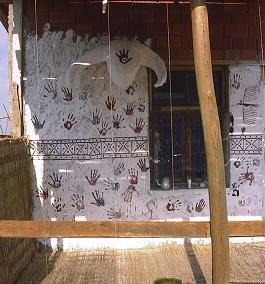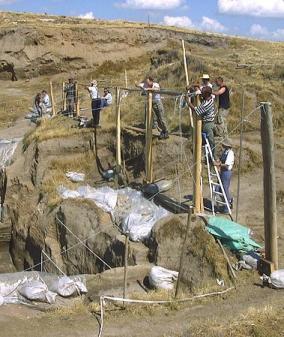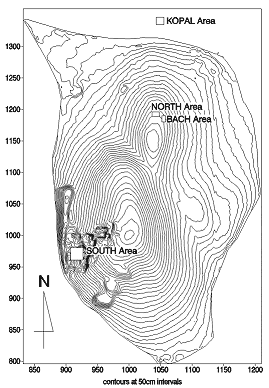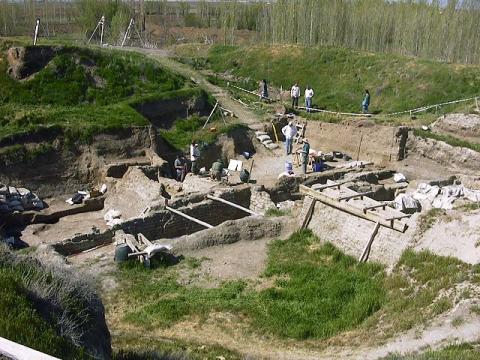Introduction
This year we worked at Çatalhöyük for 6 months from April 1st. This long season was prompted by the need to evaluate possible damage to the lower levels of the site. The water table in the area around and under the site has dropped dramatically since the 1980s. This has caused drying out of the remains in the lowest levels. Do organic remains (wood, baskets, textiles etc) survive in these levels? Evaluation of this threat to the site also allowed investigation of the unexcavated lowest deposits. What was life at Çatalhöyük when the site began? To answer these questions a team of 20 British, Turkish and international professionals worked from April to September. The team concentrated on digging a 'deep sounding' down 6m to the base of the mound in the South area of the site (Figure 1). In this we were successful reaching the natural lake marl. No waterlogged organic remains were found although water did start coming in to the trench when we hit the lake marl.
Figure 2: The South Area Excavations in April 1999
During July, August and September the BACH team worked on the North of the mound on Building 3, and off the site to the north the KOPAL team excavated a large trench. The survey team led by Douglas Baird also joined us in the summer months. Work was also undertaken to allow us to put an original Neolithic building on display and to build an experimental reproduction of a Neolithic building.
 Figure 3: The newly decorated bar/veranda |
When the 6-month Team arrived in April, it was still very cold in the Konya region, and the dig house had to be upgraded with heaters and hot water geysers to make it inhabitable. It soon warmed up through the day, but we were always glad to have the heating in the evenings. By May, the temperatures were mostly forgotten as the mound and surrounding area burst into flower. Some keen gardeners among the 6-monthers dug over a plot next to the hut at the back of the dig house, and planted it with vegetables, herbs and flowers. It was a great success and provided an additional space for recreation, bursting with flowers and supplying us with fresh rocket, spinach, tomatoes and cucumbers to name but a few. We also tidied up the area in front of the hut, whitewashed and decorated the walls, to make an outdoor 'bar' area, where many successful parties were held (Figure 3). |
In early summer, several of the Friends of Çatalhöyük came and visited the site staying overnight with us in the dig house. Later towards the end of the season, James and Arlette Mellaart also visited us, as always we are grateful for their interest in our work at the site and their helpful comments. Media interest remains high and we were visited by both local and international journalists and television crews.
However, our activities in 1999 were very much affected by the August earthquake. While this had no physical impact at the site, the emotional shock was severe. Some members of the team went to work in the worst affected zones. Those on site were thankful to Başak Boz for arranging a fundraising event at which the project and project members contributed $1000 to the relief effort and the earthquake victims. Public events such as our usual press day were cancelled. Much was achieved this year in terms of structural developments on site. Firstly, a new Shelter was erected over the south Area, to protect archaeology and excavators from the summer sun (Figure 4 and Figure 27), secondly, a permanent shelter was constructed to protect Building 5 (North area) from the elements while allowing visitors to see it throughout the year (Figure 28). |
 Figure 4: Everyone helped to construct the South Area shelter |
During 1999 members of the project have contributed to a volume of papers about the excavation and research methodology employed at Çatalhöyük, which should be published soon:
-
Hodder, I. (ed), (2000) Towards Reflexive Method in Archaeology: the Example of Çatalhöyük. Members of the Çatalhöyük teams. McDonald Institute of Archaeological Research.
During the years 2000 and 2001 we are planning to study the material from the excavations in the North and South areas 1995-1999 and publish the results. We are therefore not intending to excavate in these areas, although work will continue on other parts of the site.

Figure 5: The East Mound 1999
